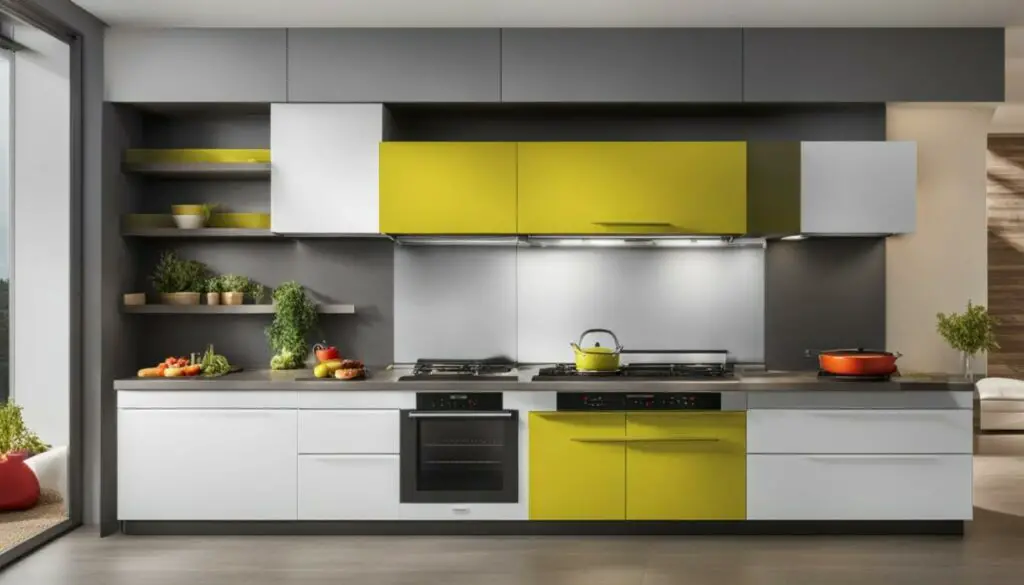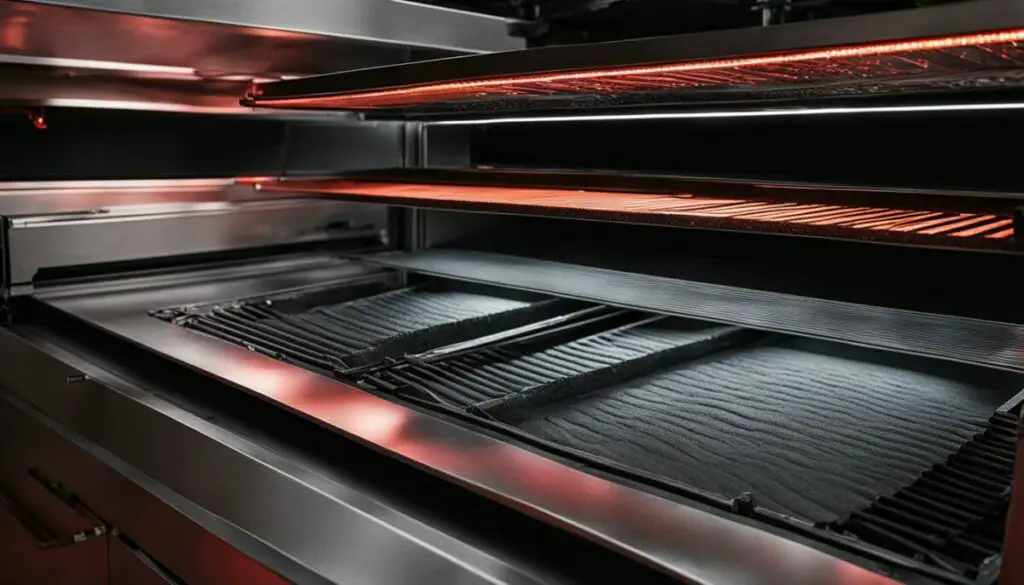Last Updated on 4 months by Francis
Are infrared ovens worth it? If you’re considering investing in a new oven for your kitchen, you may be wondering if the benefits of infrared ovens are worth the investment. Infrared ovens use infrared radiation to heat objects directly, resulting in efficient and even cooking. They have gained popularity in both commercial and residential settings due to their energy efficiency, quick heating capabilities, and compact size.
In this quick guide, we will explore the advantages of infrared oven technology and help you decide if they are worth considering for your kitchen. Let’s dive in and discover the benefits of infrared ovens.
Contents
Key Takeaways
- Infrared ovens use infrared radiation to heat objects directly, resulting in efficient and even cooking.
- They are known for their energy efficiency, quick heating capabilities, and compact size.
- Infrared ovens offer advantages such as reduced cooking times, improved flavors, and juicier meats.
- They are versatile and suitable for various applications, from cooking and baking to curing and drying.
- For those looking for cost-effective cooking solutions, infrared ovens can save energy and provide enhanced cooking experiences.
What are Infrared Ovens?

Infrared ovens are an innovative type of oven that utilize infrared radiation to heat objects and cook food. Instead of relying on traditional heating methods, infrared ovens emit infrared waves that directly transfer heat energy to the molecules of the objects they come into contact with. This unique heating technology allows for efficient and precise cooking.
There are several types of infrared ovens available, each designed to cater to different applications and needs. From small countertop models for residential kitchens to larger industrial-grade ovens, there is a wide range of options to choose from. Infrared ovens find extensive use in commercial kitchens, residential settings, and various industrial processes.
Types of Infrared Ovens:
- Countertop Infrared Ovens: These compact ovens are perfect for residential kitchens with limited counter space. They offer convenience and versatility for everyday cooking and baking needs.
- Convection Infrared Ovens: These ovens combine the benefits of infrared heating with convection technology, providing fast and even cooking results. They are popular in commercial kitchens and professional baking operations.
- Industrial Infrared Ovens: Designed for heavy-duty use, industrial infrared ovens offer robust construction and larger capacities. They are utilized in various industrial processes such as curing, preheating, and drying materials.
Infrared ovens are widely used for cooking, baking, roasting, curing, preheating, and drying. They offer precise temperature control and efficient heating, resulting in reduced cooking times and energy savings. With their versatile applications and advanced heating technology, infrared ovens have become a popular choice for chefs, bakers, and industry professionals alike.
How Do Infrared Ovens Operate?

Infrared ovens make use of advanced infrared oven technology to produce efficient and precise cooking results. These innovative ovens operate by harnessing the power of infrared radiation to transfer heat energy directly to the objects they encounter.
Infrared radiation consists of invisible waves with wavelengths ranging from 780 nm to 1 mm. When these waves come into contact with food or materials, they are absorbed, leading to efficient and even heating.
The key to the effectiveness of infrared ovens lies in their ability to target specific objects. By using reflectors, infrared ovens direct the emitted energy towards the desired target, resulting in precise and rapid heating.
One of the notable advantages of infrared ovens is their fast heating capabilities. With the ability to quickly transfer heat energy, these ovens significantly reduce cooking times compared to traditional ovens.
Furthermore, infrared ovens are renowned for their energy efficiency. By directly heating the objects being cooked, they eliminate the need to heat up the surrounding air, resulting in reduced energy consumption.
Additionally, infrared ovens excel at maintaining optimal temperatures throughout the cooking process. By providing even and consistent heat transfer, they ensure that food is cooked thoroughly and evenly.
Overall, the infrared oven technology revolutionizes heat transfer in cooking, offering faster cooking times, energy efficiency, and precise heating capabilities. The combination of these factors makes infrared ovens a popular choice for both professional kitchens and home cooking enthusiasts.
Advantages of Infrared Ovens

Infrared ovens offer several advantages that make them a popular choice for both residential and commercial kitchens. Let’s explore the key benefits of using infrared ovens:
- Energy Efficiency: One of the significant advantages of infrared ovens is their energy efficiency. Unlike traditional convection ovens, infrared ovens don’t waste energy by heating the air. Instead, they directly transfer heat to the objects being cooked, resulting in less energy consumption and lower utility bills. This eco-friendly feature makes infrared ovens a sustainable choice for those who prioritize energy efficiency in their kitchens.
- Quick Heating: Another notable advantage of infrared ovens is their quick heating capabilities. Thanks to the infrared radiation technology, these ovens can reach the desired cooking temperature within seconds, significantly reducing preheating time. The rapid heating ensures faster cooking, allowing you to prepare meals more efficiently and save valuable time in the kitchen.
- Even and Consistent Cooking: Infrared ovens provide uniform heating throughout the cooking process, resulting in even and consistent cooking results. Unlike conventional ovens that may create hotspots or uneven heat distribution, infrared ovens use targeted heating to ensure every part of the food receives the same amount of heat. This results in perfectly cooked dishes with excellent flavor and texture.
- Compact Size: Infrared ovens are designed to be compact and space-efficient, making them ideal for small kitchens or limited countertop space. Their sleek and slim design allows for easy integration into any kitchen layout without compromising on performance or cooking capacity. If you have a tiny kitchen or need to optimize your workspace, an infrared oven can be the perfect solution.
In summary, infrared ovens offer a range of advantages, including energy efficiency, quick heating, even cooking, and compact size. With these benefits, it’s no wonder why more and more people are considering infrared ovens for their cooking needs.
Considerations When Selecting Infrared Ovens
When selecting an infrared oven, there are several key factors to consider in order to find the best fit for your needs:
- Energy Source: Infrared ovens can be powered by electricity, propane, or natural gas. Choosing the right energy source depends on factors such as cost, availability, and environmental considerations.
- Specifications: Evaluate the oven’s specifications, including filtration controls, weight, and temperature range. These features will determine the oven’s capabilities and suitability for your specific cooking requirements.
- Temperature Control: Consider the level of temperature control needed for your cooking applications. Home use may require simpler controls, while industrial settings could benefit from programmable controllers that allow precise temperature adjustments.
- Rate of Growth: If you anticipate increased cooking demands, it’s essential to choose an infrared oven that can accommodate your rate of growth. Consider factors such as cooking capacity and scalability.
- Oven Size: Assess the space available in your kitchen or workspace to determine the appropriate size of the infrared oven. Ensure it fits seamlessly into your existing setup without compromising any other functions.
- Safety Features: Prioritize safety by considering the oven’s safety mechanisms, such as automatic shutdown features, lockable doors, and heat-resistant materials. These features protect both the operator and the surrounding environment.
- Budget: Set a budget and compare the cost of different infrared oven models. Consider factors such as initial purchase cost, operating expenses, and long-term maintenance requirements.
- Maintenance Requirements: Evaluate the maintenance needs of the infrared oven. Check for easy-to-clean surfaces, removable parts for deep cleaning, and the availability of technical support or service centers.
Taking these considerations into account will help you select the most suitable infrared oven that meets your cooking requirements, budget constraints, and long-term growth plans.
Infrared Ovens vs Traditional Ovens

Infrared ovens offer several advantages over traditional ovens. The direct heating method of infrared ovens allows for faster and more efficient cooking, resulting in reduced cooking times. Infrared ovens also provide more even cooking due to the direct transfer of heat to the food or objects being cooked. Additionally, infrared ovens are energy efficient and smaller in size, making them suitable for small kitchens or limited spaces. Traditional ovens, on the other hand, rely on convection or conduction heating methods and may have hot spots or uneven heating.
When it comes to cooking with infrared heat, the direct and efficient transfer of heat makes a significant difference. Infrared ovens heat the food directly, resulting in faster cooking times, while traditional ovens rely on heating the air and then transferring the heat to the food. This indirect heating method can lead to longer cooking times and uneven cooking results.
Here are some key differences between infrared ovens and traditional ovens:
| Infrared Ovens | Traditional Ovens |
|---|---|
| Direct heat transfer | Indirect heat transfer |
| Faster cooking times | Longer cooking times |
| Even cooking results | Potential for uneven cooking |
| Energy efficient | Higher energy consumption |
| Smaller size | Larger size |
As shown in the table above, infrared ovens offer advantages in terms of direct heat transfer, faster cooking times, and even cooking results. They are also more energy efficient and smaller in size compared to traditional ovens. These features make infrared ovens a popular choice for those looking for efficient and effective cooking methods.
Applications of Infrared Ovens

Infrared ovens have a wide range of applications that make them versatile and valuable in various industries and settings. Let’s explore some of the key applications of infrared ovens:
Cooking, Baking, and Roasting:
Infrared ovens are commonly used for cooking, baking, and roasting food in both commercial and residential kitchens. Their ability to quickly and evenly heat food makes them ideal for preparing delicious meals with consistent results.
Curing Processes:
In industries such as automotive painting, electronics manufacturing, and powder coating, infrared ovens are essential for curing processes. They provide controlled heating that ensures the even and efficient curing of coatings, adhesives, and other materials.
Drying Materials:
Infrared ovens are effective in drying various materials, such as paint, ink, and paper. The targeted heating provided by infrared radiation helps remove moisture quickly and efficiently, reducing drying time and improving production efficiency.
Preheating Objects:
Infrared ovens are used to preheat objects before further processing. This is particularly useful in industries that involve molding, forming, or shaping materials. By preheating objects, infrared ovens enhance the efficiency and quality of subsequent manufacturing processes.
Applying Coatings:
Infrared ovens are also utilized in the application of coatings, such as powder coatings. The intense heat generated by infrared radiation helps melt and evenly distribute the coating material, resulting in a smooth and flawless finish.
The applications of infrared ovens are diverse and extend beyond cooking. Their efficient heating capabilities, precise temperature control, and targeted heat distribution make them indispensable in a wide range of industries.
| Application | Industry |
|---|---|
| Cooking, Baking, and Roasting | Food service, residential |
| Curing Processes | Automotive, electronics, powder coating |
| Drying Materials | Printing, packaging, manufacturing |
| Preheating Objects | Manufacturing, metalworking |
| Applying Coatings | Powder coating, painting |
Are Infrared Ovens Worth It? User Experiences
When it comes to the question of whether infrared ovens are worth the investment, many users have given a resounding “Yes!” Their positive experiences with infrared ovens showcase the numerous benefits they bring to the table.
One of the standout features of infrared ovens is their fast heating capabilities. Users appreciate how quickly these ovens reach their desired cooking temperatures, saving them valuable time in the kitchen. Whether it’s preheating for a weeknight dinner or baking a batch of cookies, infrared ovens excel in providing efficient heating.
Another aspect that users love about infrared ovens is their energy efficiency. These ovens use infrared radiation to directly heat the food or objects being cooked, bypassing the need to heat up the surrounding air. This targeted heating approach allows for more efficient energy usage and ultimately leads to lower utility bills.
In addition to speedy heating and energy efficiency, users consistently report even cooking results with infrared ovens. The direct transfer of heat to the food ensures that it cooks evenly, without hot or cold spots. This results in dishes that are cooked to perfection, with enhanced flavors and textures.
“Since getting my infrared oven, I’ve noticed a significant improvement in cooking times and the overall quality of the food. Everything comes out juicier and more flavorful. It’s definitely worth every penny!” – Mary, Home Cook
The compact size and ease of use of infrared ovens are also highly praised by users. These ovens are designed with convenience in mind, making them perfect for small kitchens or limited spaces. Whether you’re a seasoned chef or a cooking novice, infrared ovens are user-friendly and intuitive.
Overall, user experiences with infrared ovens have been overwhelmingly positive, showcasing the value and worth of these innovative appliances. From fast heating and energy efficiency to even cooking results, infrared ovens provide a superior cooking experience that is well worth the investment.
What Users Love About Infrared Ovens:
- Fast heating capabilities
- Energy efficiency
- Even cooking results
- Enhanced flavors and juicier meats
- Compact size and ease of use
Conclusion
After considering the numerous advantages of infrared ovens, it is clear that they are worth investing in for your kitchen. Whether you are a professional chef in a bustling restaurant or a home cook looking to elevate your culinary skills, infrared ovens offer a range of benefits that make them a valuable addition to any kitchen.
One of the key advantages of infrared ovens is their energy efficiency. By directly heating the food or objects being cooked, they eliminate the need to heat the surrounding air, resulting in significant energy savings. This not only reduces your carbon footprint but also cuts down on utility costs in the long run.
In addition to energy efficiency, infrared ovens also excel in quick heating and even cooking. Their precise heat transfer capabilities ensure that your food is cooked evenly, eliminating any hot spots or uneven cooking. This not only enhances the flavors and textures of your dishes but also saves you time in the kitchen.
Considering the long-term energy savings, improved cooking experiences, and versatility in applications, investing in an infrared oven is a cost-effective choice. Whether you’re cooking for yourself, your family, or a large group, an infrared oven will undoubtedly enhance your cooking capabilities, allowing you to prepare delicious meals with ease.
FAQ
Are infrared ovens worth it?
Yes, infrared ovens are worth it due to their energy efficiency, quick heating capabilities, and even cooking results.
What are infrared ovens?
Infrared ovens are ovens that use infrared radiation to heat objects or cook food. They heat objects directly and cook food without heating the surrounding air.
How do infrared ovens operate?
Infrared ovens operate by emitting infrared waves that transfer heat energy to the molecules of the objects they come into contact with, resulting in efficient and even heating.
What are the advantages of infrared ovens?
The advantages of infrared ovens include energy efficiency, quick heating, even cooking, and their compact size.
What should I consider when selecting infrared ovens?
When selecting infrared ovens, consider the energy source, specifications, temperature control options, and other factors such as size, safety features, and maintenance requirements.
How do infrared ovens compare to traditional ovens?
Infrared ovens offer faster and more efficient cooking, even cooking results, and energy efficiency compared to traditional ovens that rely on convection or conduction heating methods.
What are the applications of infrared ovens?
Infrared ovens are commonly used for cooking, baking, curing processes, drying materials, preheating objects, and applying coatings in various industries and settings.
What do users say about infrared ovens?
Users have reported positive experiences with infrared ovens, appreciating their fast heating capabilities, energy efficiency, even cooking, and ease of use.
Are infrared ovens worth it?
Yes, infrared ovens are worth it as they offer numerous advantages, including energy efficiency, quick heating, even cooking, and versatility in applications, making them a cost-effective option.



.jpg)





